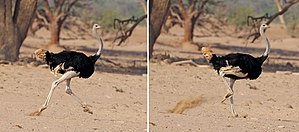
Back Bipedie Afrikaans ثنائيات الحركة Arabic Bipediya Azerbaijani Daoudroadegezh Breton Dvonožnost BS Bipedisme Catalan Bipedie Czech Bipedie German Dupiedulo Esperanto Bipedestación Spanish

Bipedalism is a form of terrestrial locomotion where an animal moves by means of its two rear (or lower) limbs or legs. An animal or machine that usually moves in a bipedal manner is known as a biped /ˈbaɪpɛd/, meaning 'two feet' (from Latin bis 'double' and pes 'foot'). Types of bipedal movement include walking or running (a bipedal gait) and hopping.
Several groups of modern species are habitual bipeds whose normal method of locomotion is two-legged. In the Triassic period some groups of archosaurs (a group that includes crocodiles and dinosaurs) developed bipedalism; among the dinosaurs, all the early forms and many later groups were habitual or exclusive bipeds; the birds are members of a clade of exclusively bipedal dinosaurs, the theropods. Within mammals, habitual bipedalism has evolved multiple times, with the macropods, kangaroo rats and mice, springhare,[4] hopping mice, pangolins and hominin apes (australopithecines, including humans) as well as various other extinct groups evolving the trait independently. A larger number of modern species intermittently or briefly use a bipedal gait. Several lizard species move bipedally when running, usually to escape from threats.[5] Many primate and bear species will adopt a bipedal gait in order to reach food or explore their environment, though there are a few cases where they walk on their hind limbs only. Several arboreal primate species, such as gibbons and indriids, exclusively walk on two legs during the brief periods they spend on the ground. Many animals rear up on their hind legs while fighting or copulating. Some animals commonly stand on their hind legs to reach food, keep watch, threaten a competitor or predator, or pose in courtship, but do not move bipedally.
- ^ Stewart, D. (2006-08-01). "A Bird Like No Other". National Wildlife. National Wildlife Federation. Archived from the original on 2012-02-09. Retrieved 2014-05-30.
- ^ Davies, S.J.J.F. (2003). "Birds I Tinamous and Ratites to Hoatzins". In Hutchins, Michael (ed.). Grzimek's Animal Life Encyclopedia. Vol. 8 (2nd ed.). Farmington Hills, MI: Gale Group. pp. 99–101. ISBN 978-0-7876-5784-0.
- ^ Penny, M. (2002). The Secret World of Kangaroos. Austin, TX: Raintree Steck-Vaughn. p. 22. ISBN 978-0-7398-4986-6.
- ^ Heglund, NC; Cavagna, GA; Taylor, CR (1982). "Energetics and mechanics of terrestrial locomotion. III. Energy changes of the centre of mass as a function of speed and body size in birds and mammals". Journal of Experimental Biology. 97: 41–56. doi:10.1242/jeb.97.1.41. PMID 7086349.
- ^ Clemente, Christofer J.; Wu, Nicholas C. (2018). "Body and tail-assisted pitch control facilitates bipedal locomotion in Australian agamid lizards". Journal of the Royal Society Interface. 15 (146): 20180276. doi:10.1098/rsif.2018.0276. ISSN 1742-5689. PMC 6170770. PMID 30257922.
Cite error: There are <ref group=note> tags on this page, but the references will not show without a {{reflist|group=note}} template (see the help page).